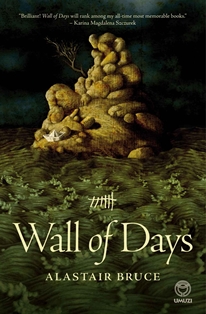
First published in the US back in August of 2010, Alastair Bruce’s debut novel ‘Wall Of Days’ found itself receiving a very welcome reception, including with its later release in the UK in August of 2011.
DLS Synopsis:
Bran lives alone on the small island that has been his home for the last ten years. His days are spent gathering food, digging peat, collecting wood and meticulously recording his day-to-day observations. Each of these days is scratched upon the cave wall in which he resides.
Outside the cave the island is always wet. It hasn’t stopped raining once for the last ten years. No matter what he does, he’s always damp. The moisture is always there. Always rotting away something – including the very island itself.
But Bran’s world suddenly changes when he sees a motionless body lying on the beach, pale, bloated and seemingly lifeless, having no doubt been washed by the sea. The body belongs to the Marshal of Axum – a man named Andalus. The man had ruled over the neighbouring Axum territories that had been at war for many years with the people of Bran. And after many years at war, the two territories finally came to a peace agreement. A truce that was orchestrated by the two Marshals – Bran and Andalus. And now, after all these years, the two are face to face once again.
With his whole world now thrown off-kilter, Bran knows it is his duty to take Andalus back to the people that had cast Bran away all those years ago. Although he still resents their guilty dismissal of the great leadership that he once gave to the people of Bran, he knows that he must make them aware that something strange is happening with the people of Axum. Although their Marshal is merely a shell of a man now, disturbed into a state of muteness, there must still be a reason for his sudden arrival on the isolated and remote island.
Although a possible and very probable death awaits Bran upon returning to the land whence he was banished for his supposed crimes, he knows that he must nevertheless take the journey with Andalus in tow. Bran knows he must face up to his past, finally confront the ghosts that haunt him to this day, and hopefully find forgiveness or an end to it all. In a world where merely existing is a carefully calculated struggle in itself, tough choices are inevitable. It’s just making sure that you can live with the consequences that counts…
DLS Review:
Set in a dystopian post-apocalyptic future where sparse amounts of land is left above the water level, the tale sets off with a very Robinson Crusoe-esque scenario, with the principal character of Bran detailing his self-sufficient lifestyle upon the isolated island. Bran’s meticulous record keeping and mathematical calculations of the slowly disappearing islands remaining lifespan, creates an ingenious layer to the character’s profile which is mesmerising in itself. The sheer depth characterisation of Bran is nothing short of incredible. The sympathies and emotional bonds formed with this incredible survivor are absolutely second to none.
Bruce chooses to slowly unravel the many mysteries that surround the character of Bran, his apparent crimes, the community he was once the Marshal of, and indeed his ultimate motivations for returning to the community he was banished from. This gradual uncovering of the facts and indeed the novel’s overall premise, laces the tale with a long-standing intrigue that the author manages to maintain at almost a constant peak. This in itself is a hell of an achievement. Many of the important answers are there, and in time they are revealed, but along the way the author has much territory he wishes to explore (or re-explore in Bran’s case).
Upon returning to the community of Bran, the author sets down an atmospherically eerie village that seems devoid of almost all signs of life. Much like the underlying creepiness Lovecraft produced within the labyrinth of deserted streets in his classic short ‘The Shadow Over Innsmouth’ (1936), the village of Bran is portrayed in a purposefully ‘somehow-not-right’ manner; constantly creeping further and further under the reader’s skin.
The challenging political and ethical elements pretty much bring the whole storyline together; with much of the novel dedicated to the emotional consequences and crushing guilt that is a direct consequence of Bran’s previous brutal dictatorship. The novel quickly becomes completely immersed in the constant raw emotions of our protagonist and narrator. Emotions that seems to swallow the character whole, bringing up intriguing notions of his questionable sanity.
The novel is as bleak as it is gut-wrenching. The tale keeps together a firm pace, uncovering mysteries and answering unspoken questions as the storyline charges on. The writing itself is very accomplished, perfectly capturing the stark emotions that carve out the ultimate direction of the tale, whilst painting a vivid picture of the challenging new world where human life is so precariously perched on the brink of (possible) extinction.
Comparisons to J.G. Ballard’s ‘The Drowned World’ (1962), George Orwell’s ‘Nineteen Eighty-Four’ (1949), Aldous Huxley’s ‘Brave New World’ (1932) and perhaps even aspects of Simon Clark’s ‘King Blood’ (1997) can certainly be made. Indeed, much of the post-apocalyptic backdrop is far from original in itself. However, where the real strength of the novel lies is with the emotional and political backbone that the author explores so tenderly. Here the tale becomes enjoyably thought-provoking as well as morally inquisitive.
The tale runs for a total of 237 pages.
© DLS Reviews






